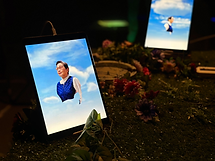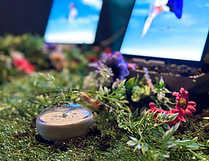"WE CAN SEE EACH OTHER ANYTIME"(2024)
Exhibition Size: H 4000mm × W 2000mm × D 3015mm
Work Size: Screen: H 2500mm × W 2000mm × D 50mm
Display Stand: H 900mm × W 900mm × D 900mm
Medium : Looped video (2 minutes), pipe, Ricoh PJ WX4152 projector, 4 iPads, agricultural polyethylene, artificial grass, artificial flowers, clock, styrofoam blocks, soil, display stand, lamp
A few years ago, on my birthday, my grandfather—who had been suffering from dementia—passed away.
At his funeral, my family decided not to display a portrait of him. I was surprised by this choice, but later learned that using framed photos as memorial portraits at funerals only became common in recent decades, with the spread of photography.
We often think of a memorial portrait as a framed photograph capturing the person's smile and energy while they were alive.
But this experience made me wonder: what if the way we preserve someone’s memory—what we consider a “portrait”—could evolve in the near future?
This work is an artistic proposal for how we might memorialize loved ones in a near-futuristic way.
① I closely observed my grandmother for several weeks, recording her everyday actions and gestures. I also interviewed people close to her and asked them to reenact behaviors she was known for. These moments were recorded on video.
② I 3D-scanned her body to digitally preserve her form.
By projecting these recordings of my grandmother, moving as she normally would, onto a transparent screen, this installation creates the experience of being able to visit her as she was—whenever I want.
What I regret most about my grandfather’s funeral is that I had no moving images of him from before his dementia.
As his condition worsened, he was moved to a care facility, and in his final years I only saw him bedridden. The last time I saw him, he was lying stiff and emaciated in his casket—there was no trace of the lively person I remembered.
While a few cheerful photos from his life remain, I can no longer recall his voice, his catchphrases, or his subtle mannerisms. Now, I can only try to mentally reconstruct what kind of person he might have been, relying on secondhand accounts from my parents and grandmother.
If I had a video of him from when he was well—walking, speaking, laughing—I could revisit those memories even after forgetting.
This installation was born from that wish: to preserve not just an image, but the living presence of someone we love.




"DO YOU PROMISE TO LOVE AND CHERISH EACH OTHER FOREVER ?"(2024)
Medium: Matte Paper
Size: 1000mm × 2000mm
A child is often seen as the visible embodiment of a couple’s love—a precious being who carries the hope of humanity into the future.
That’s what we believed without question.
Yet in reality, divorce rates in Japan have risen significantly, with one in three marriages now ending in separation.
So what becomes of the child who was once born as a “proof of love”?
Even when the love between the parents fades, the child remains—left behind in the space that love once occupied.
Then how should a child, left in the aftermath of love’s absence, go on living?
The title of this work, "Do you swear to love for a lifetime?", is originally a question posed by a priest to a bride and groom during a wedding ceremony.
But here, the question is not directed at another person—
It is a vow turned inward.
Do you have the courage to love yourself—completely, and for a lifetime?
"FINALLY, I MET THE PERSON"(2024)
Meduim: Video (7 minutes 22 seconds)
Directed by miyuu
Assistant: AgoMika
Music: Bitachi Sozai-kan, Re:I
Filming Locations: Shinjuku Gyoen, TUG Shinjuku
Nekoyama, is a "浪人"ronin (a student repeating a year) who has failed his entrance exam to art school and spends lonely days by himself. One day, through social media, he meets a fellow ronin named Macaroni, and they gradually grow closer.
They agree to meet in person and spend time drawing together in a park. As they spend more time together, Nekoyama begins to develop feelings for Macaroni. However, the boundary between reality and his idealization of her becomes blurred. The "ideal Macaroni" he has created in his mind slowly diverges from the real Macaroni in front of him.
Overwhelmed by his emotions, Nekoyama impulsively confesses his feelings, only to be rejected bluntly.
This story portrays the phenomenon of inflating one's ideal image of a romantic partner, only to be confronted with the reality that the person in front of you is an individual with their own will—not simply a fulfillment of your desires and hopes. It is a poignant yet realistic narrative.








